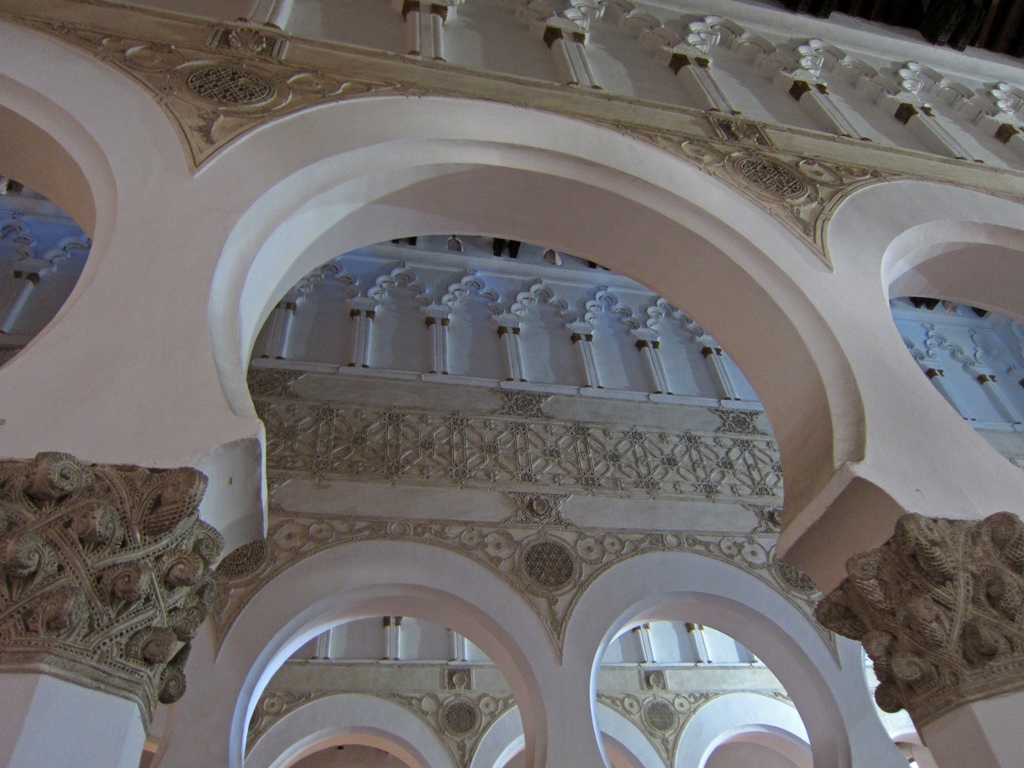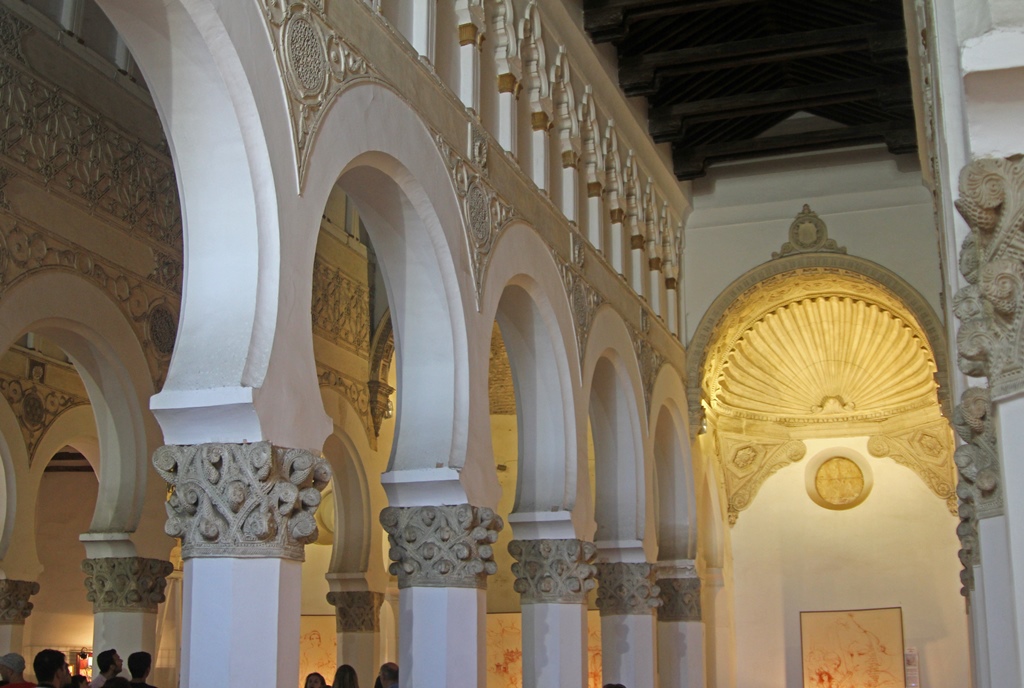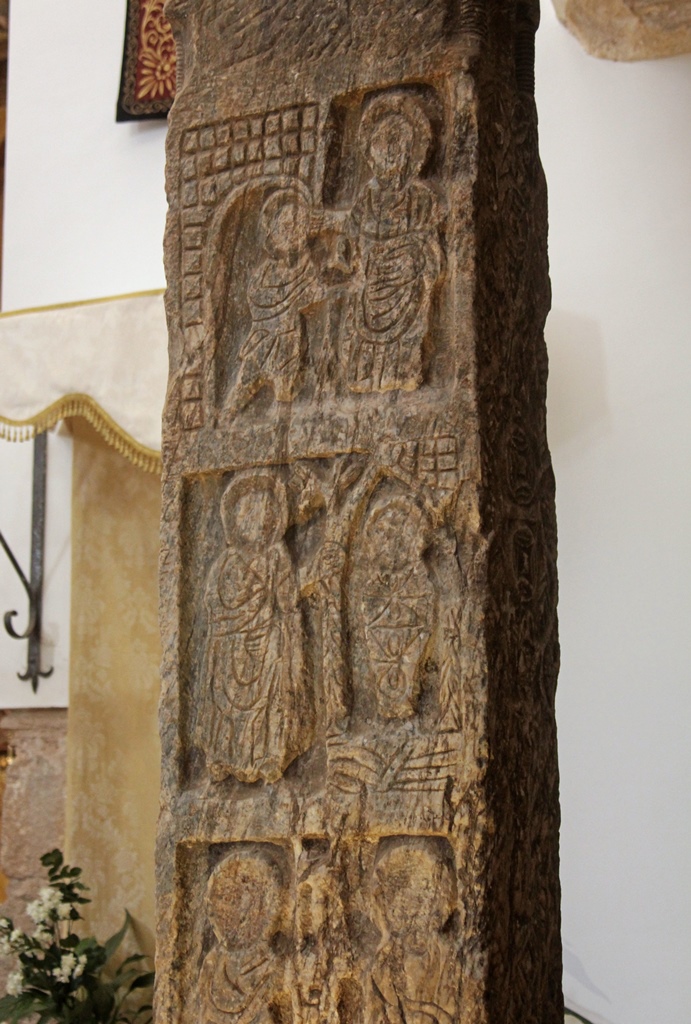When we entered the San Juan Monastery for our visit (see
previous page), a sign listed the
options for the entrance fee. For adults, a la carte entry was actually quite inexpensive (I don't
remember what it was exactly, but even today, a number of years later, it's less than 3 euros). But
alternatively, we were presented with the choice of buying a wristband (for a higher fee) which would
get us into several religious Toledo landmarks (mainly churches) for the day, or until it was removed
or broken. They didn't actually call it Church-O-Rama (it's
La Pulsera Turística de Toledo –
a pulsera is a bracelet, though the actuality would have to be considered less than decorative),
but if they see this, I expect they'll want to change to this clearly superior name. I won't charge them.
Not much, anyway. We did the math and figured that we'd have to visit three additional churches to get
our money's worth, which we decided was easily doable. As it turned out, we ended up visiting five
churches all together. The first was the San Juan Monastery (previous page) and the last was the Jesuit
Church (next page), and the other three, which will
be discussed in this page, were the Santa María Synagogue, the Santo Tomé Church and the Church of El
Salvador.
First we headed for
the synagogue, which was
actually pretty close to the San Juan Monastery. On the way, we noted that there were tiles with Jewish
symbols embedded in the pavement, indicating that we were entering the Jewish Quarter.
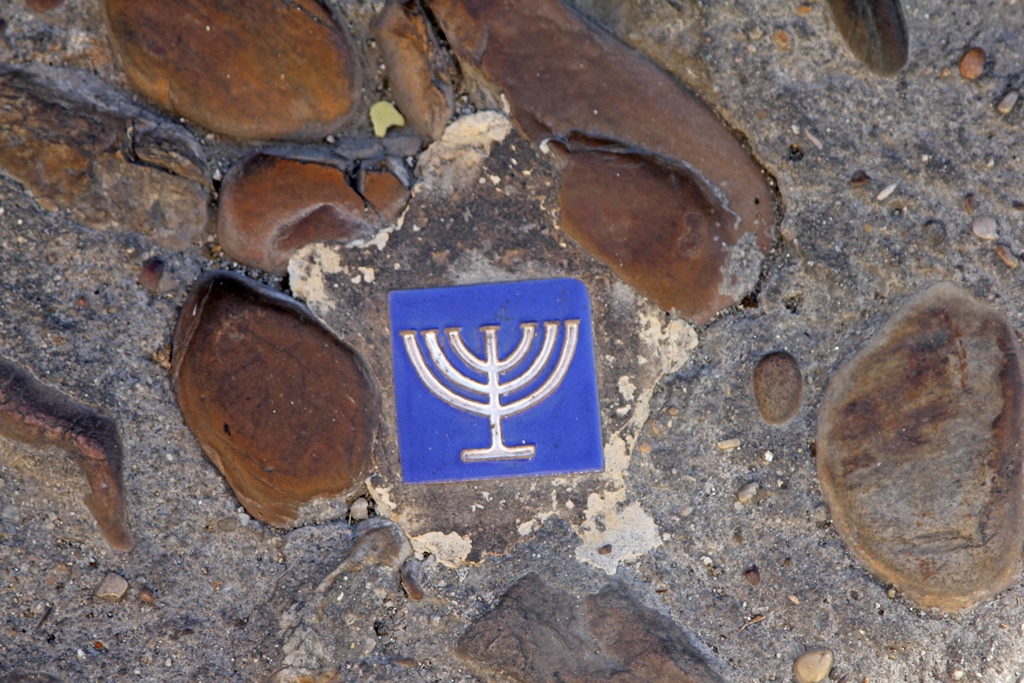
Menorah Tile
But weren't Jews eliminated from Spain in 1492, through expulsion and forced conversion? Also, the
name of the Santa María Synagogue (Sinagoga de Santa María La Blanca) might have you scratching
your head. After all, Christians don't have synagogues, and Jews don't have St. Marys. And entering
the synagogue, the style of decoration is clearly Islamic, which doesn't clarify anything.
First of all, the presence of Jews in the neighborhood considerably predates 1492's Alhambra Decree
which outlawed Judaism in Spain, and even Alfonso VI's 11th Century capture of the city from the Moors.
"Jewish Quarter" is mainly an historical reference, indicating that many pre-1492 Jews lived in this
area. It's not clear exactly when the synagogue was built, but it seems to have been created in the
late 12th or early 13th Century, under Christian rule, by Moorish architects, for use by Jews. The
synagogue has been used in modern times as evidence of a "golden age" when all three religions got
along beautifully in Toledo, but one would have to think there was a certain amount of tension among
them. Though things may have been somewhat mitigated in Spain compared to the rest of Europe, this
was the time of the Crusades, when a succession of popes was frequently asking for support in fighting
Muslims. And in the rest of Europe, persecution of Jews was widespread. In Castile, the "goldenness"
of the age could depend on a number of factors, such as the whims of the people in charge. For
example, Pedro/Peter I (1334-1369), known as "the Cruel", was actually pretty tolerant when it came to
Jews, while his successor/half-brother/murderer, Enrique/Henry II (1334-1379), was a raging anti-Semite.
Affecting the synagogue specifically was a fire-breathing sermon by an anti-Jewish visiting priest in
1405 that incited a mob to attack the synagogue, slit the throats of the Jews they found there and throw
their bodies over a parapet onto the rocks below the city. This encouraged the surviving Jews to stay
away from the building, and the Christians took it over, turning it into a church called Santa María La
Blanca, or St. Mary the White (apparently to remedy the "darkness" of the Judaism that had been
practiced there). In 1550, after the expunging of Judaism from Spain, the building and its courtyard
were turned into a monastery. The monks eventually abandoned the building after a wall collapsed, and
for centuries it was used as an armory and as a warehouse for a company that made bullfight swords. In
the 19th Century the decaying building was rescued and eventually turned into a museum, and it is
currently owned by the Catholic Church. No religious ceremonies are practiced there.
The first thing one notices on entering the synagogue is that there are a lot of Moorish-style horseshoe
arches, supported by octagonal columns with Mudéjar ("post-Moorish") capitals. There are intricate
designs and "blind" arches (arches that are filled in) above the horseshoe arches, extending to the
ceiling.
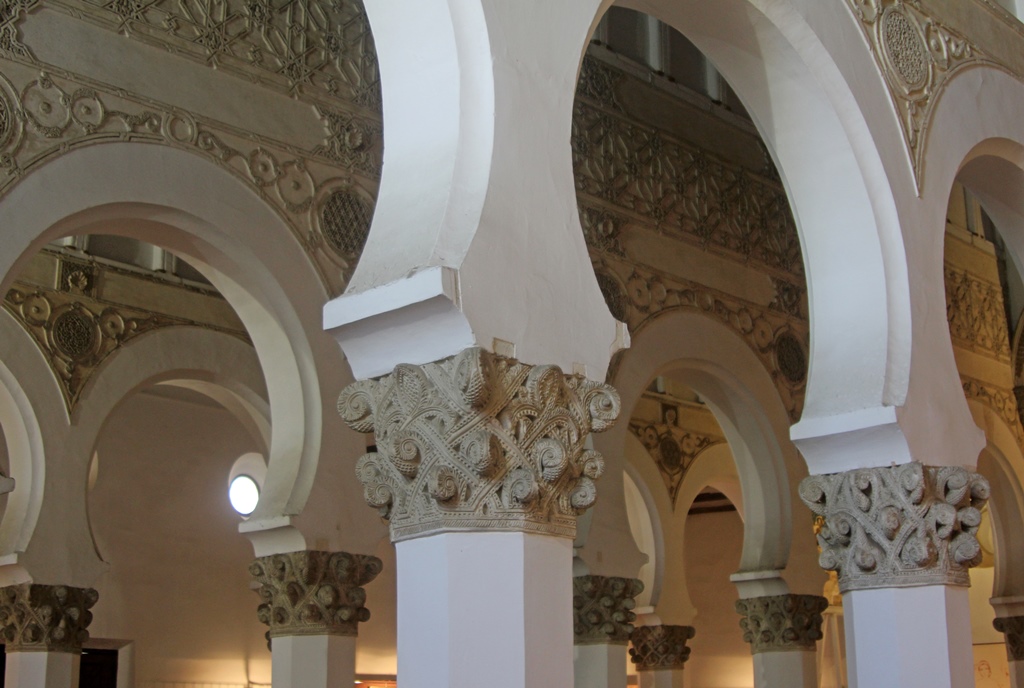
Arches with Octagonal Columns
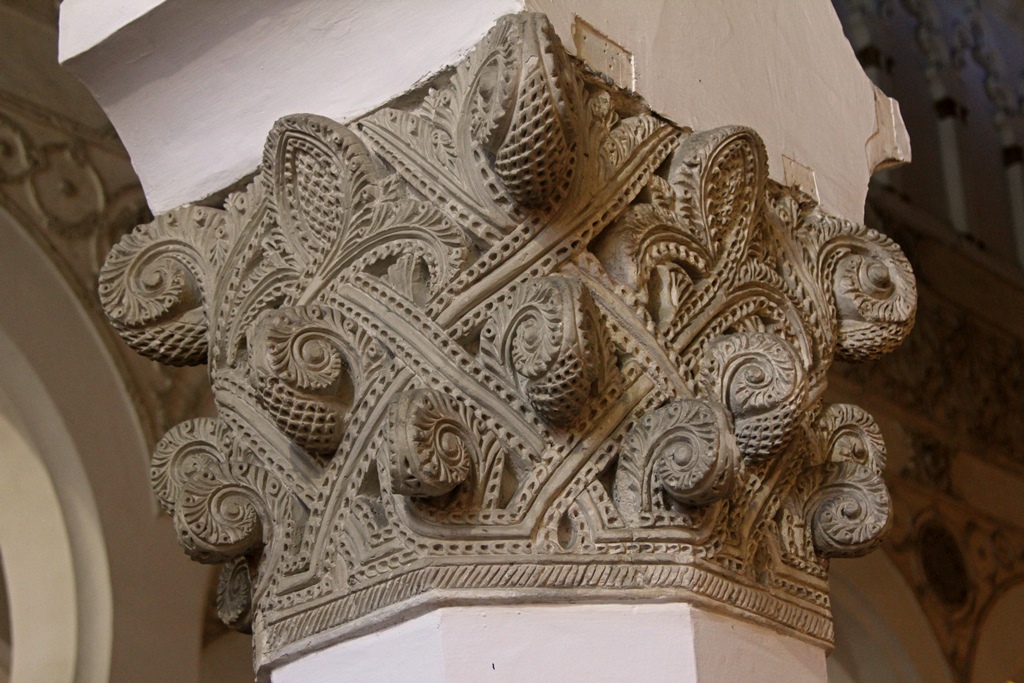
Mudéjar Capital
Horseshoe Arch with Decorations
The ceiling itself is made of wood, with dark rafters and cross-beams (and no attic). The floor
is of brick, with tiles in places. Some of the tiles have eight-pointed stars on them.
Interestingly, there are a number of eight-pointed stars in the floor and in the other decorations,
but no six-pointed stars, as one might expect in a synagogue (apparently there is one six-pointed
star in an unobtrusive corner, but we weren't aware of it at the time). The eight-pointed star,
formed by two overlapping squares, is apparently a Muslim symbol called the Rub el Hizb, used
(among other places) in the Qur'an to help with recitation. Not sure what it's doing in a
church/synagogue, but it must have seemed like a good idea at the time.
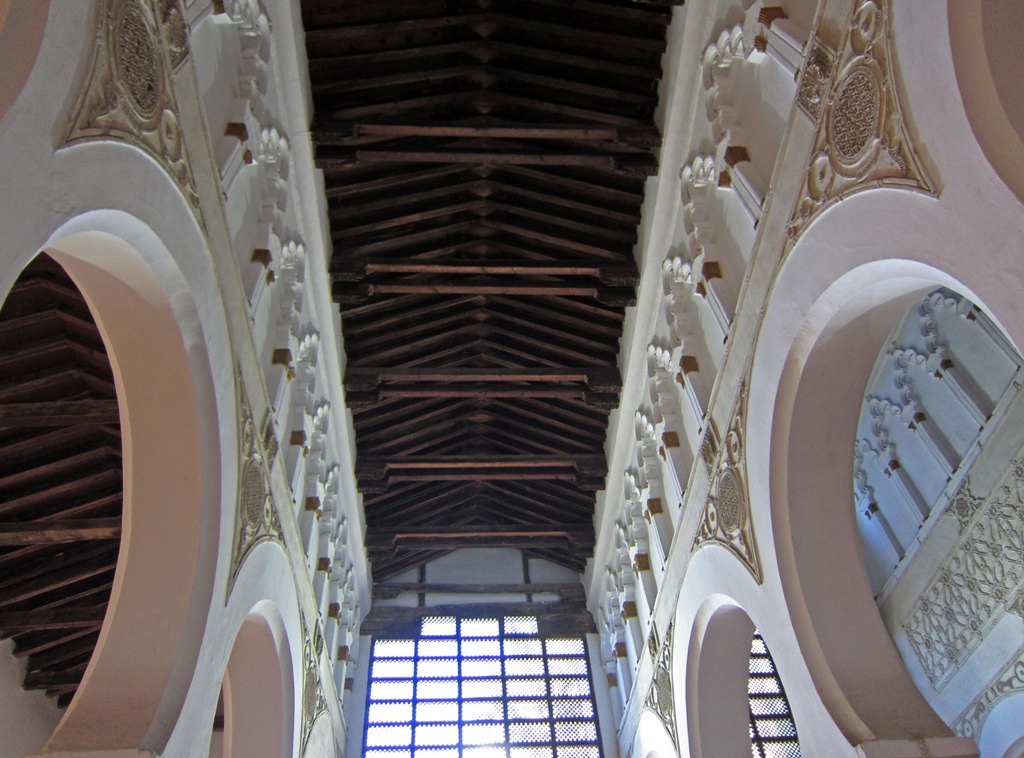
Wooden Ceiling
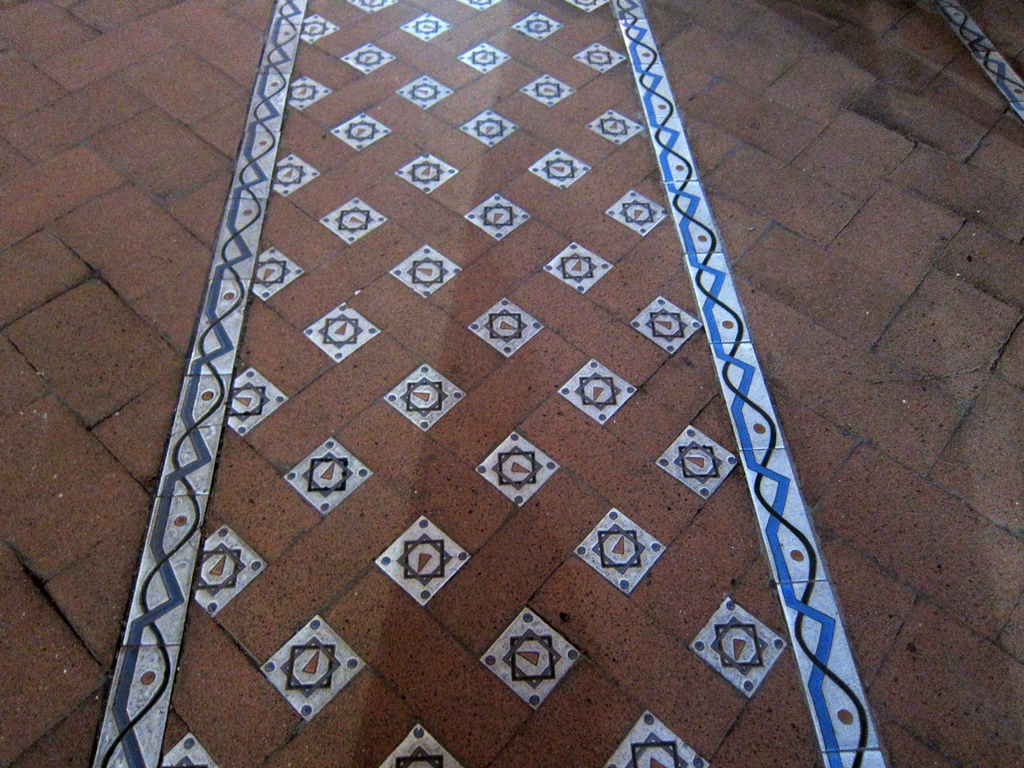
Flooring
Another thing one might notice about the synagogue is possibly an impression that it's not as
big as one might expect, or at least not as long. It is wide, however – there are five naves.
The two naves immediately flanking the center one have decorative "half-domed" ceilings. The
one on the left is better decorated than the one on the right – it's gilded, while the one on
the right is plain plaster, and part of an apparently medieval painting can be seen on one of
the walls below the gilded half-dome.
Center-Right Nave
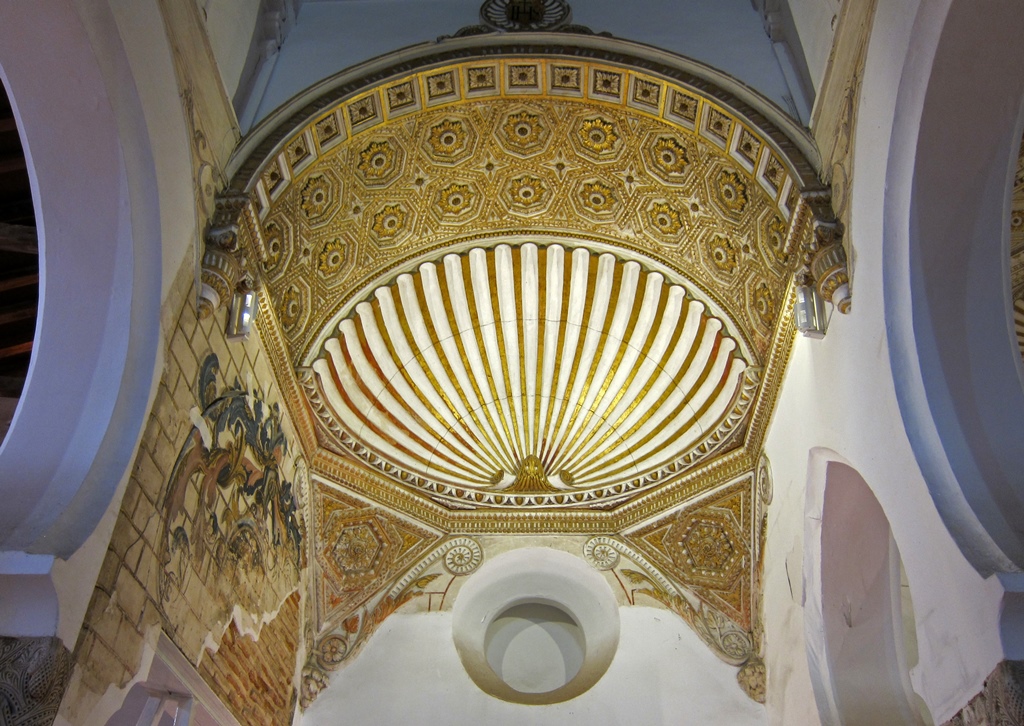
Half-Dome, Center-Left Nave
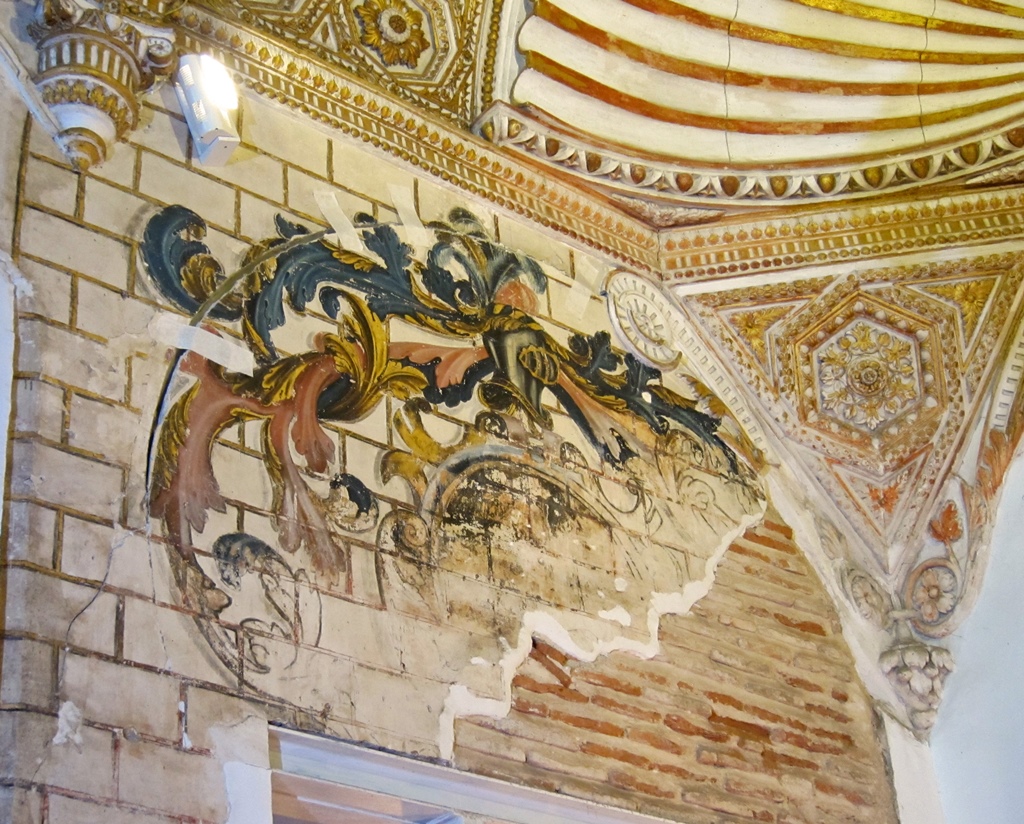
Medieval Artwork, Center-Left Nave
But the front of the central nave would have been the focus of either a Jewish or a Christian
service. There isn't too much there now – the area has a domed ceiling, with some nice gilding
and some cherubby stuff (from the Christian era no doubt) around its base. There are a simple
cross and a couple of small reliefs above the entrance to the domed area, and a couple of pointy
arched windows in the otherwise unadorned back wall. When the building was a church, there would
undoubtedly have been some kind of an altarpiece in this area, probably a pretty nice one. When
the synagogue was a synagogue, there would have been a Torah Ark here, used for storing the
synagogue's Torah scroll. The shape of the windows apparently matches that of a traditional
Sephardic Torah case.
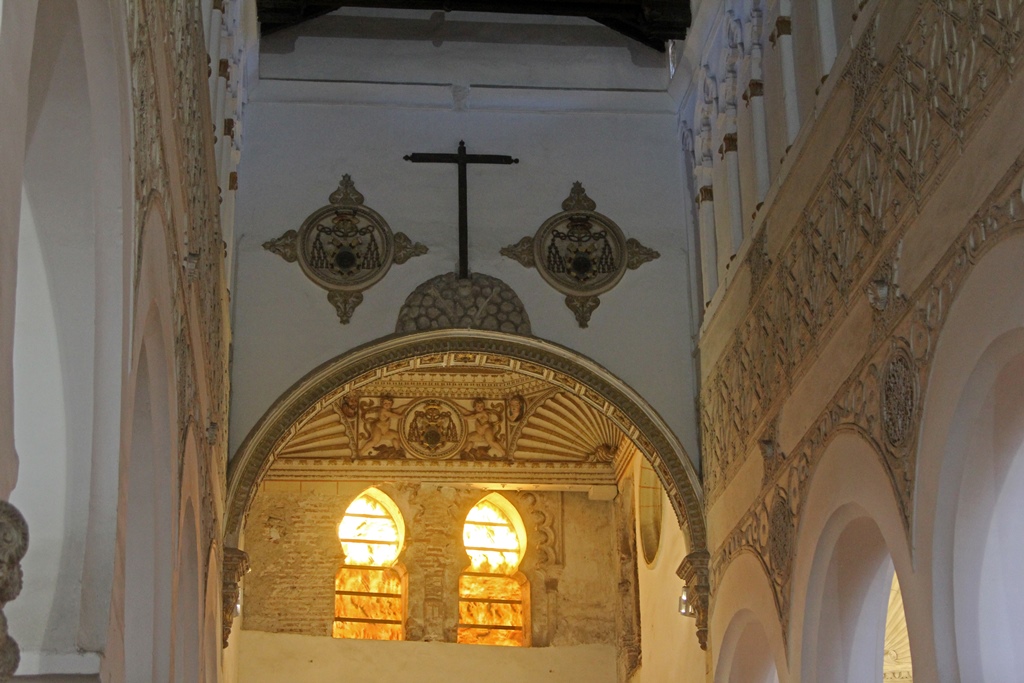
Altar/Torah Ark Area
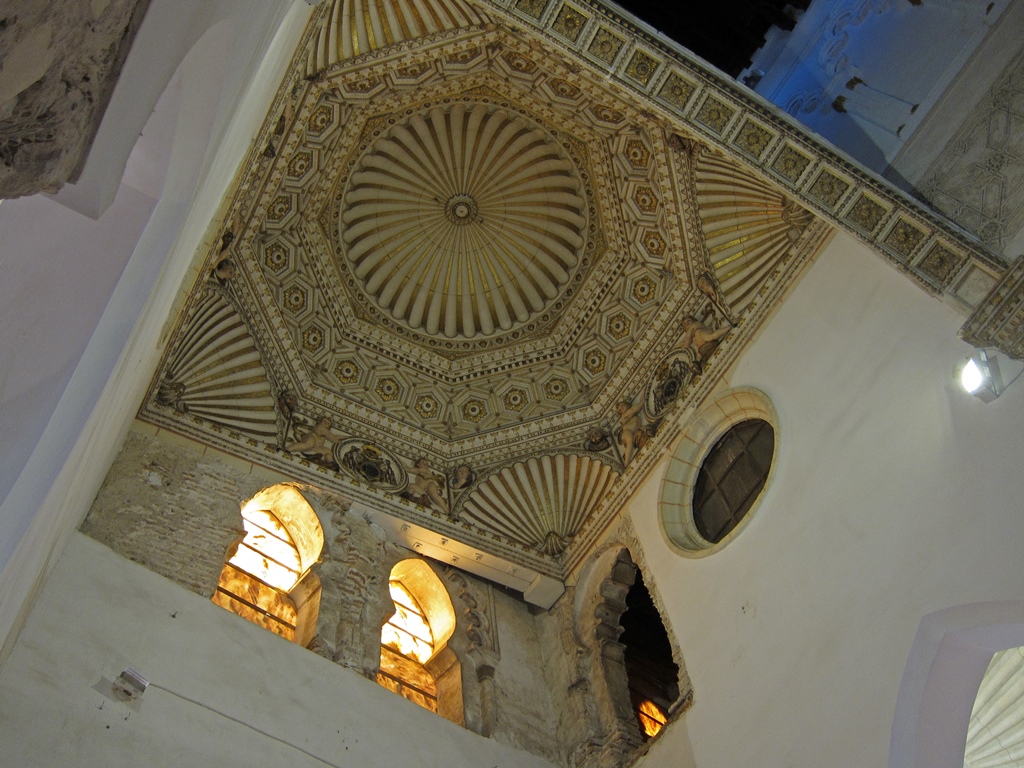
Dome and Windows
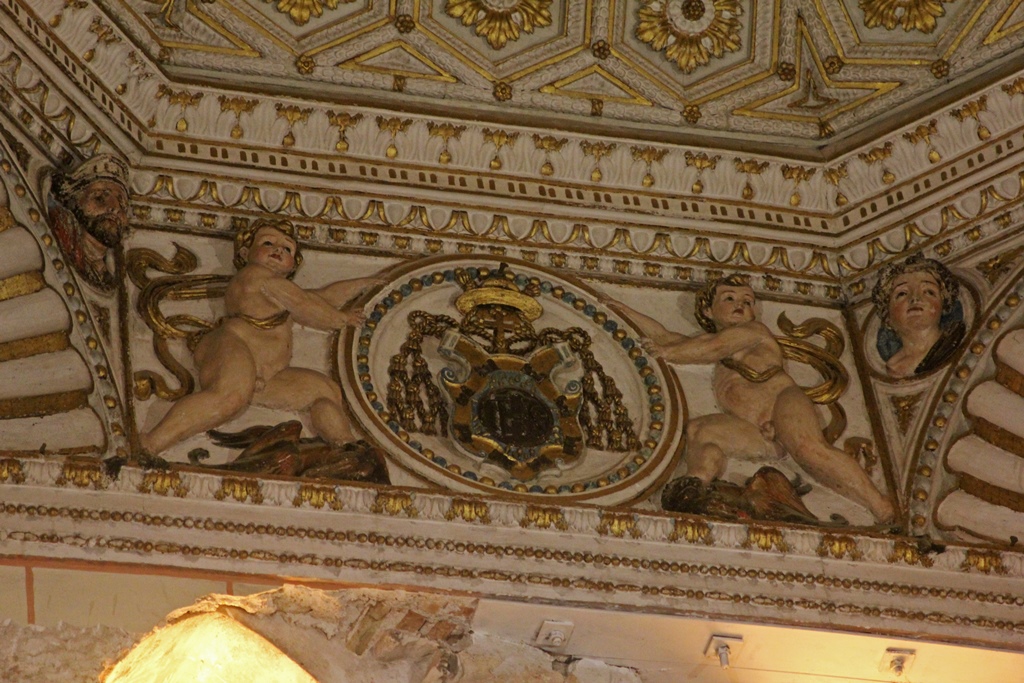
Detail, Dome Base
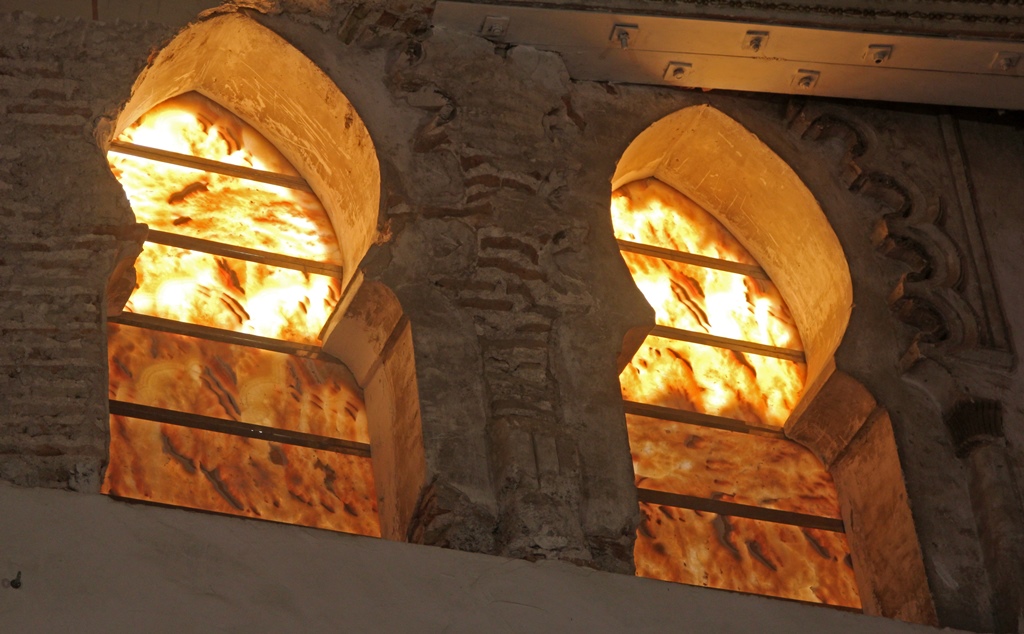
Pointy Windows
From the synagogue we walked uphill to the
Church of Santo Tomé,
whose primary claim to fame is a painting by El Greco. Externally, the church has a nice bell tower,
which we got a picture of, and a nice front door, which we did not. We did, however, photograph it
in marzipan.
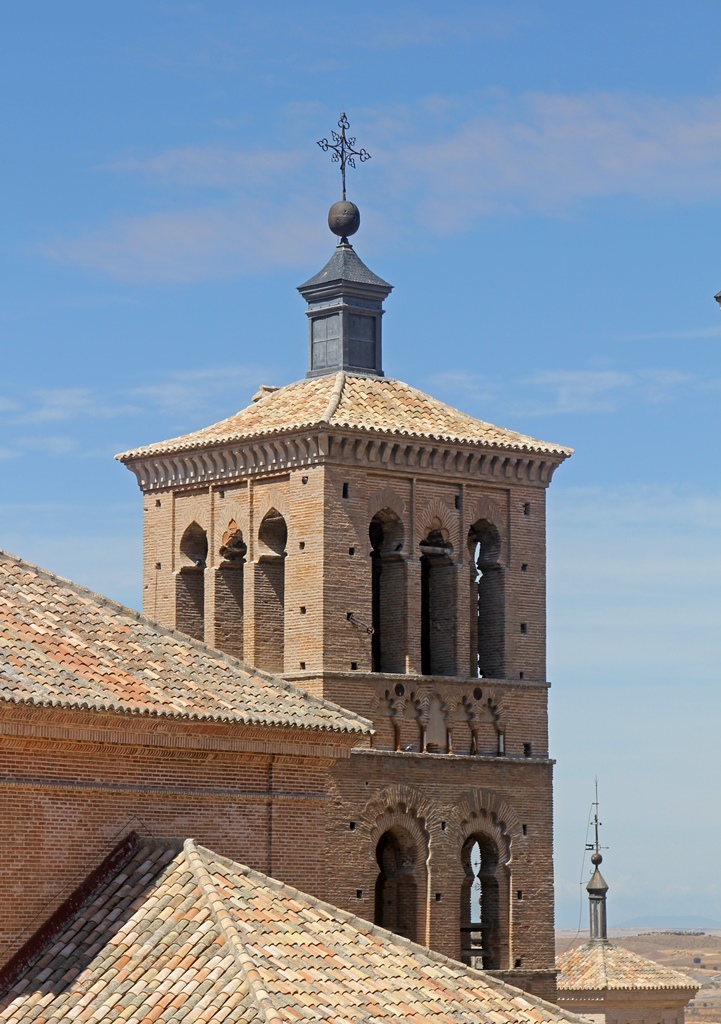
Bell Tower, Santo Tomé Church
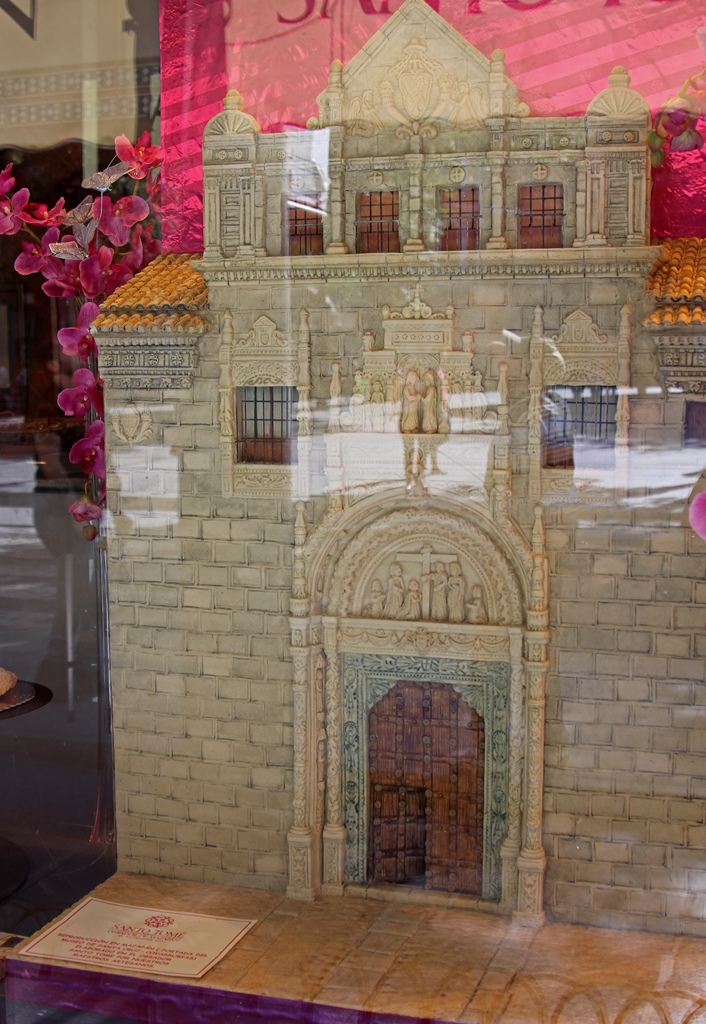
Front Door Made of Marzipan
Just inside the church entrance and to the right is the Chapel of the Conception, which is the
home of the aforementioned painting, The Burial of the Count of Orgaz. El Greco worked on
it between 1586 and 1588, and it is considered by many to be his masterpiece. Unfortunately
photography inside the church was prohibited, and they seemed to be pretty serious about it, so we
can't show it to you. However,
here's a link
to the Wikipedia page for it, where you can see the painting and read some info about it. But here's
a quick rundown for the impatient:
The painting is quite large, measuring nearly 16 feet tall and 12 feet wide. It depicts the burial of
a man named Don Gonzalo Ruíz, a native of Toledo and lord of the nearby town of Orgaz (about 20 miles
to the south, with a 21st Century population of less than 3,000), who died in 1323. His family
acquired the Count title sometime after his death, but Ruíz is commonly referred to retroactively as a
count. The Church of Santo Tomé was created shortly after the 11th Century takeover of the city by
Alfonso VI when an existing mosque was renamed and repurposed. By the end of the 13th Century, the
church was in pretty bad shape, and Don Gonzalo took it upon himself to perform a major restoration,
which saved the church. When he died, he was buried in the church's Chapel of the Conception (after a
temporary burial elsewhere as his tomb was being prepared) according to his wishes. According to
legend, Don Gonzalo's virtues were so prodigious that two saints (St. Stephen and St. Augustine) came
down from heaven to rebury him personally, as the city's startled nobility looked on. El Greco's
painting depicts this entire scene, including the crowd of prominent Toledans, the finery-clad saints,
the greenish-gray, armor-clad remains of the Count, and the expectant scene in heaven (with angels, a
crowd of saints, and or course Jesus and Mary) as the clouds are being opened up to welcome a
much-anticipated soul to their realm. All of this is presented in considerable detail (which explains
why the painting is so big) and, in a feat of compositional magic, actually makes sense. The painting
is also something of an historical document: El Greco obviously didn't know what the actual nobles at
the burial looked like, as they'd all been dead for 250 years, so as models he used prominent citizens
from his own time (this was actually written into his contract), executing each face in the crowd as
an individual portrait. And most of the faces are shown doing sensible things (such as looking at the
proceedings or at each other), not just posing. Except for one face, that of El Greco himself, who is
looking directly out at the viewer. The painting is positioned directly above the actual tomb, with
Sts. Stephen and Augustine looking like they're about to deposit the Count into it.
It can be difficult to get into a position to get a good view of the painting, as large tour groups are
continuously flowing through, gazing at the painting for a bit before leaving and making room for
succeeding groups, but with a little patience you can eventually get up to the front. And as the tour
groups are leaving, totally ignoring the rest of the church, you can go sit down in a pew or look
around at the various altarpieces, like we did. Unfortunately, photography is still verboten, so we
only got a few surreptitious shots.
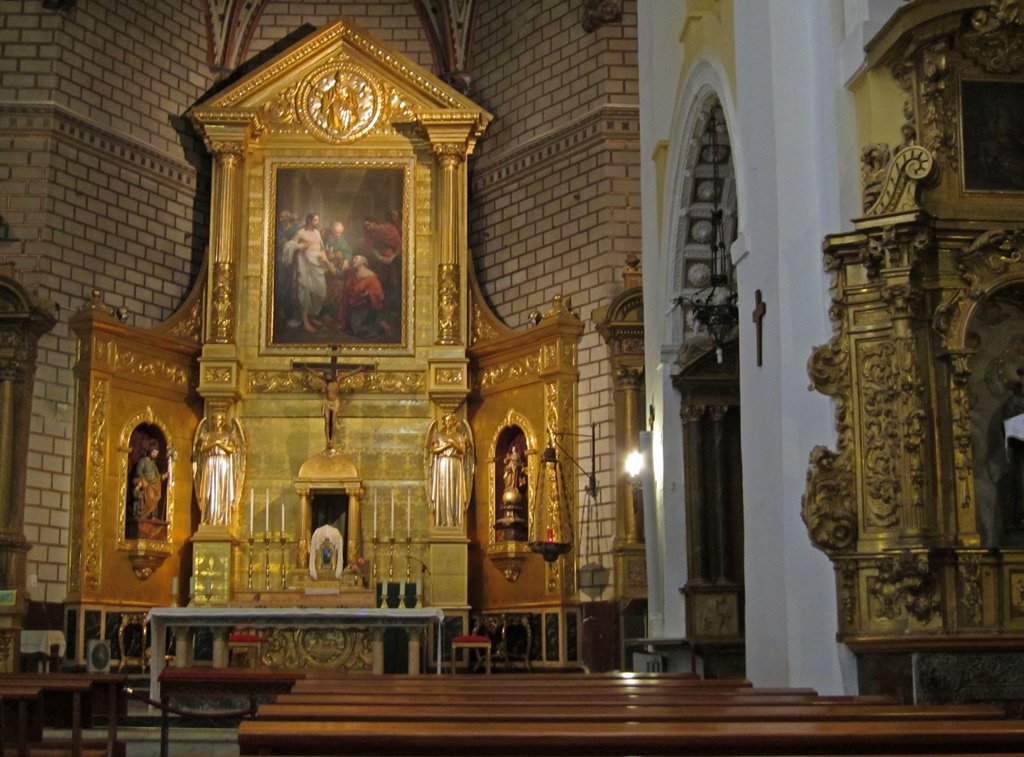
Main Altar, with Doubt of St. Thomas
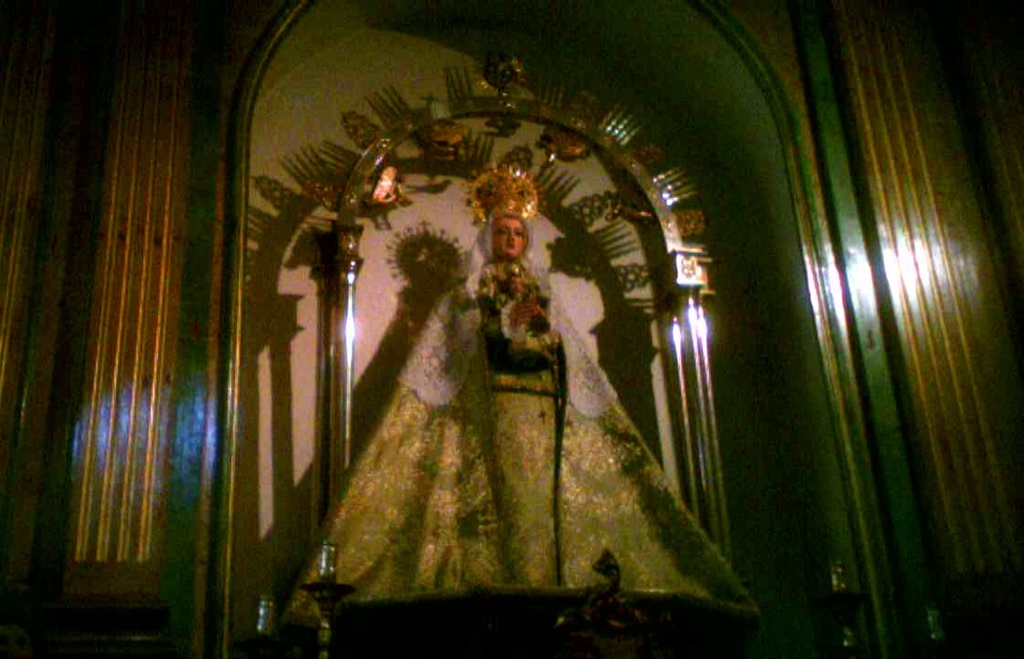
Crowned Virgin Altarpiece
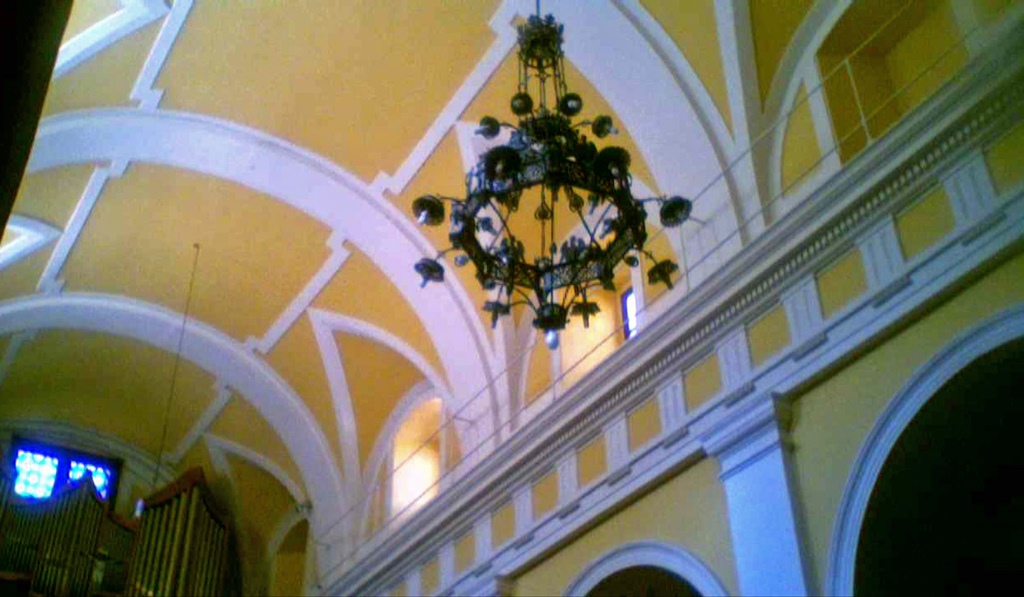
Ceiling, Chandelier and Organ
A short distance from Santo Tomé we found the
Church of El Salvador.
Our impression of the church was that it was on the compact side. The available pews appeared as
though they would hold maybe a hundred people (at most), and though there were several decorative
religious articles in the church, none of them were particularly large. Here's some of what we saw:
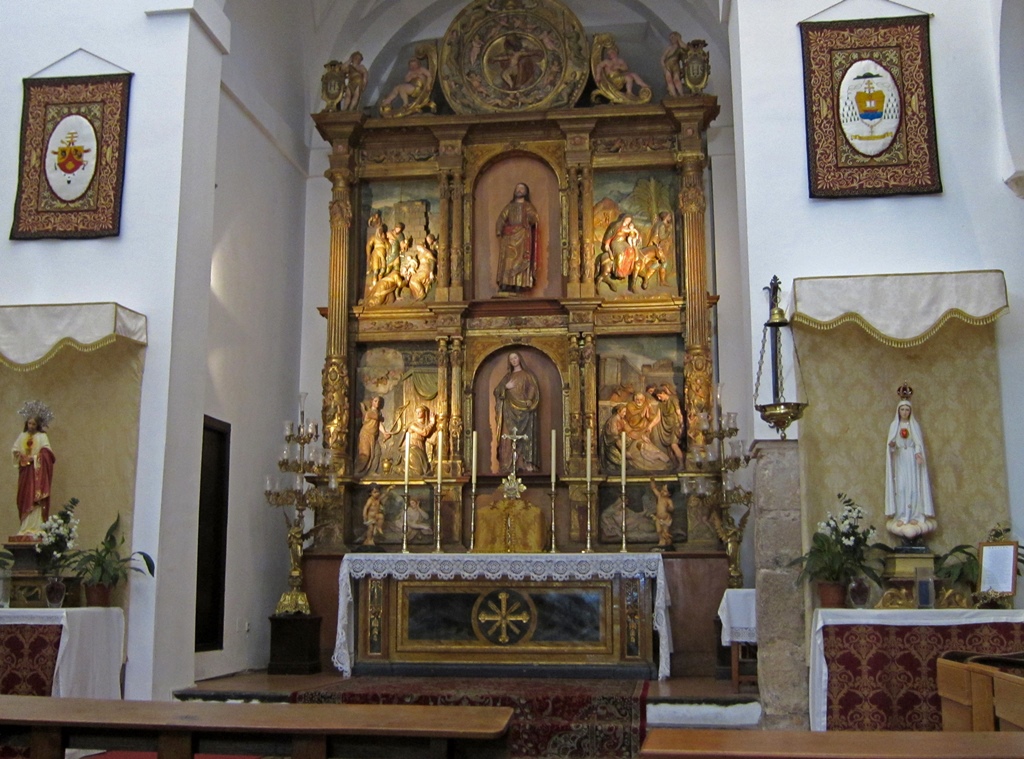
Main Altarpiece
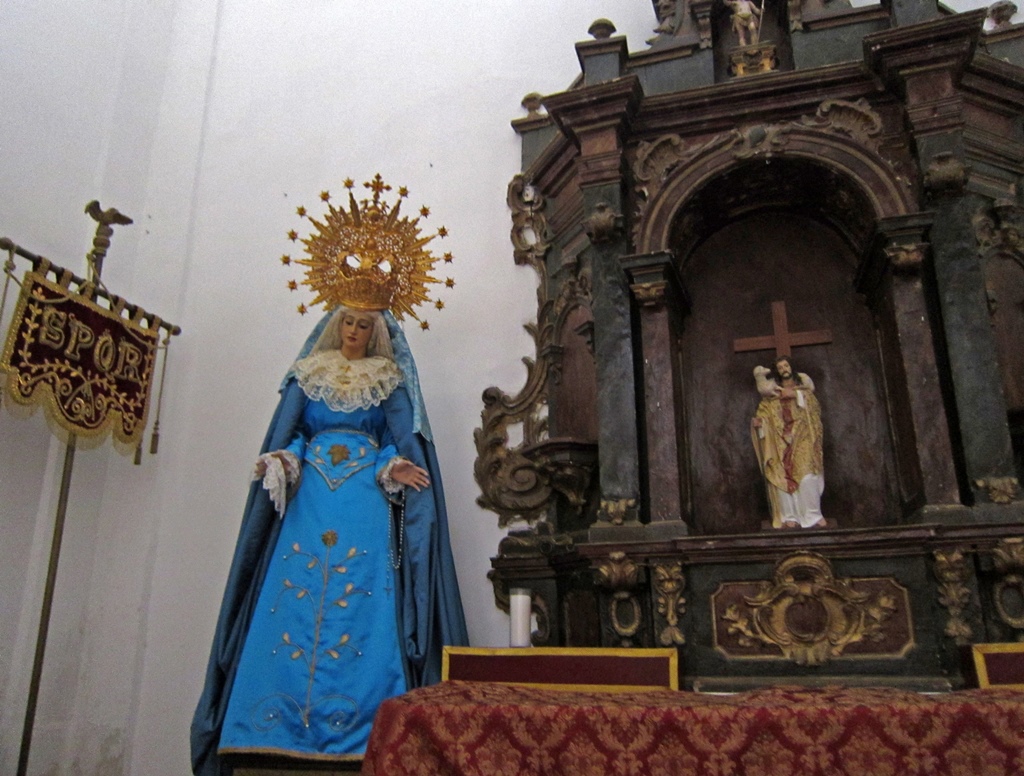
Altarpiece with Virgin Figure
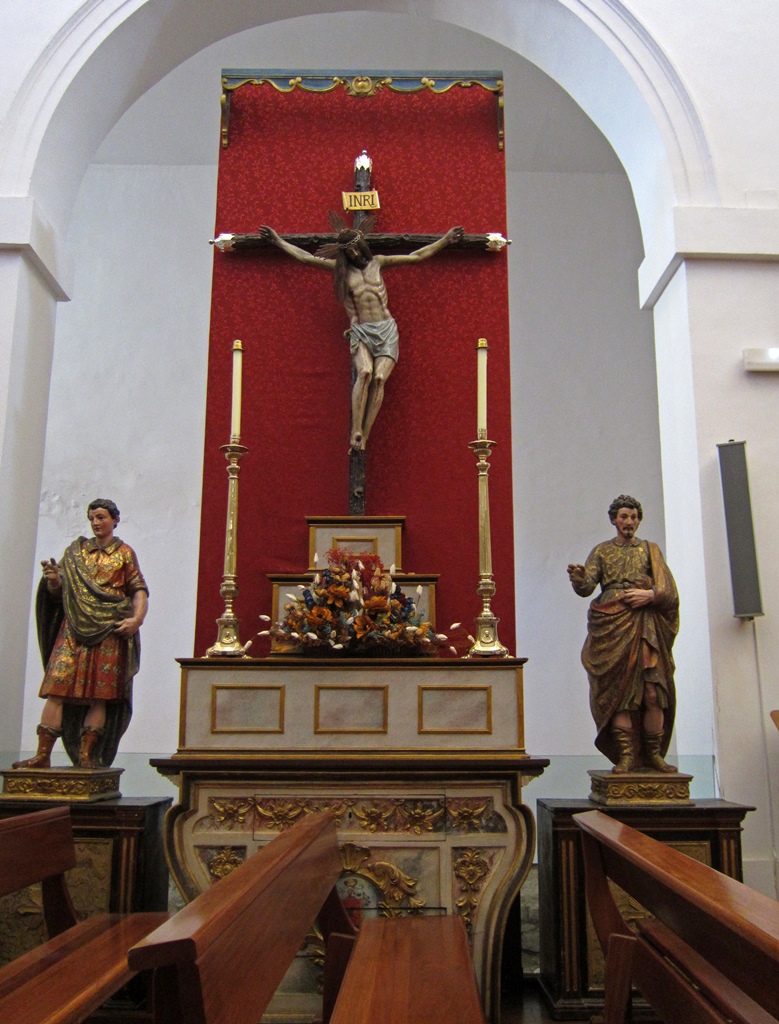
Altar with Crucifix
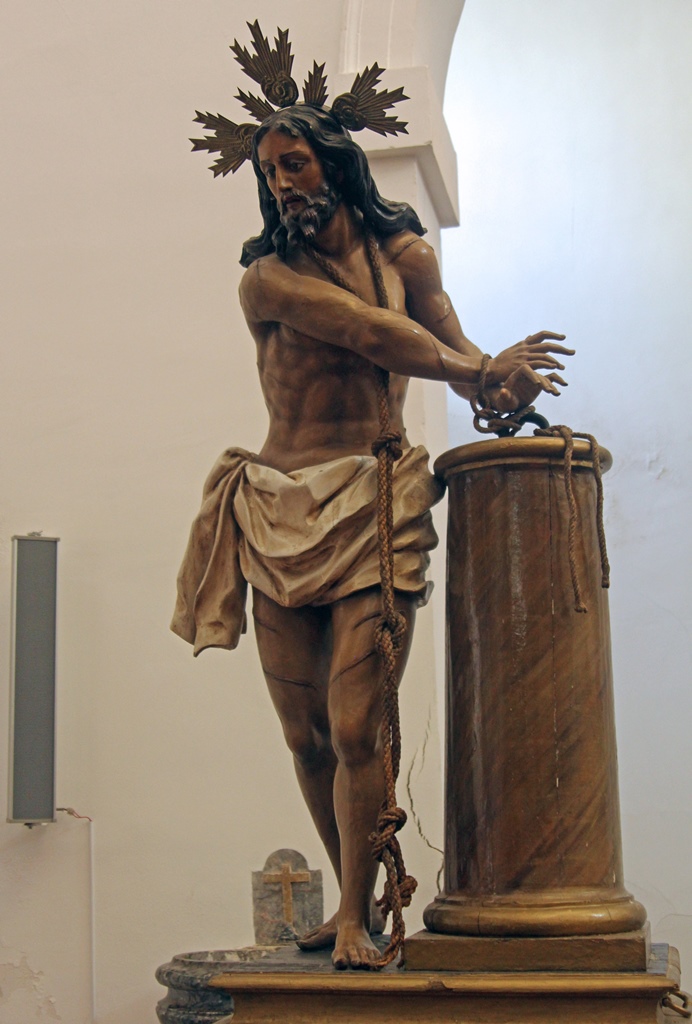
Figure of Christ with Column
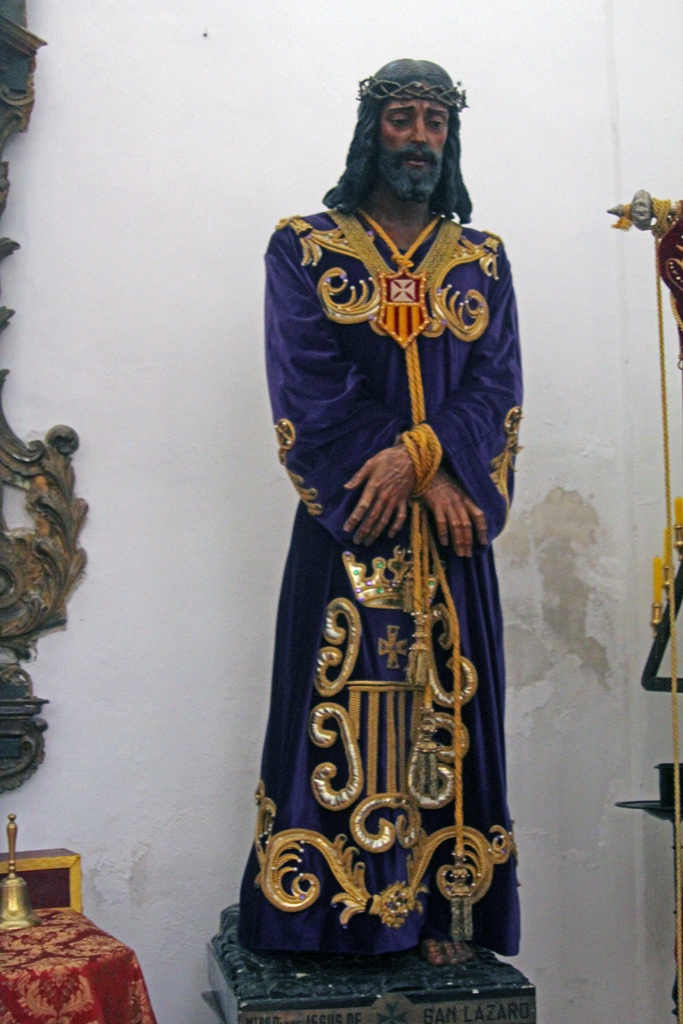
Jesus de San Lazaro Figure
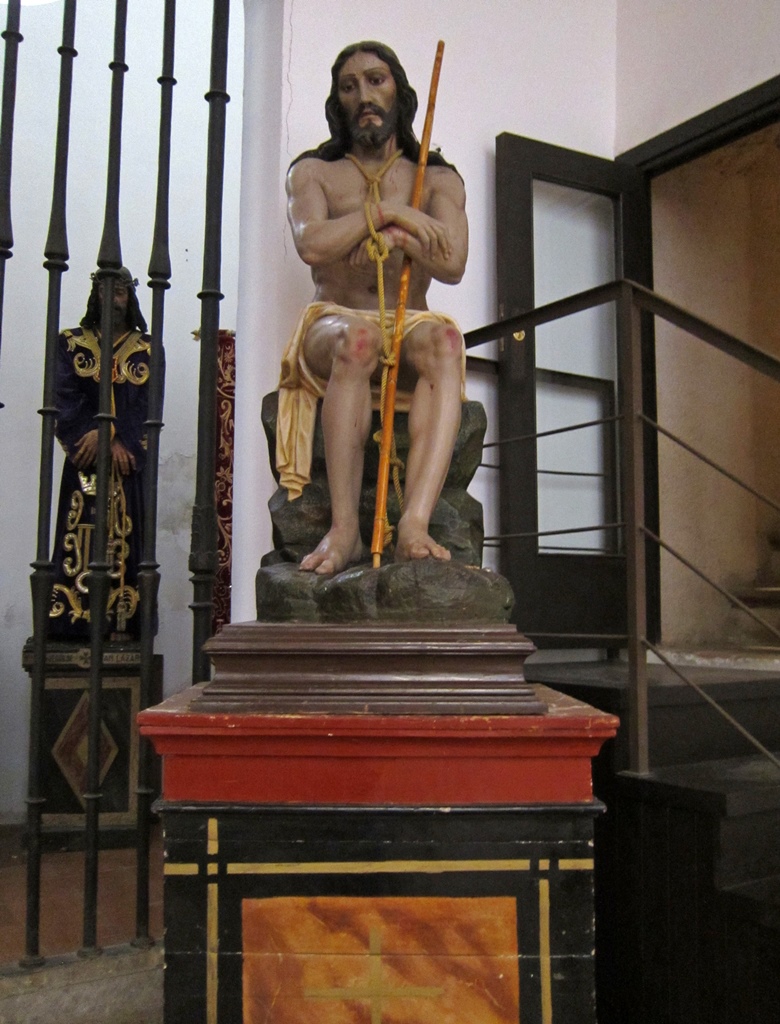
Seated Christ Figure
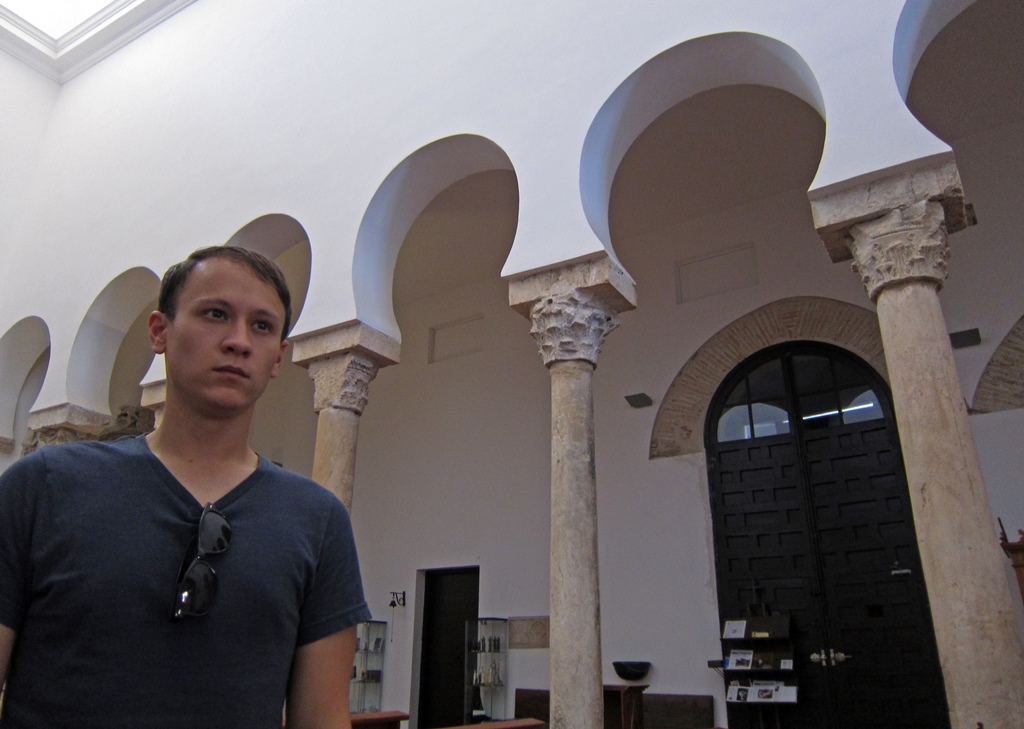
Philip and Arcade
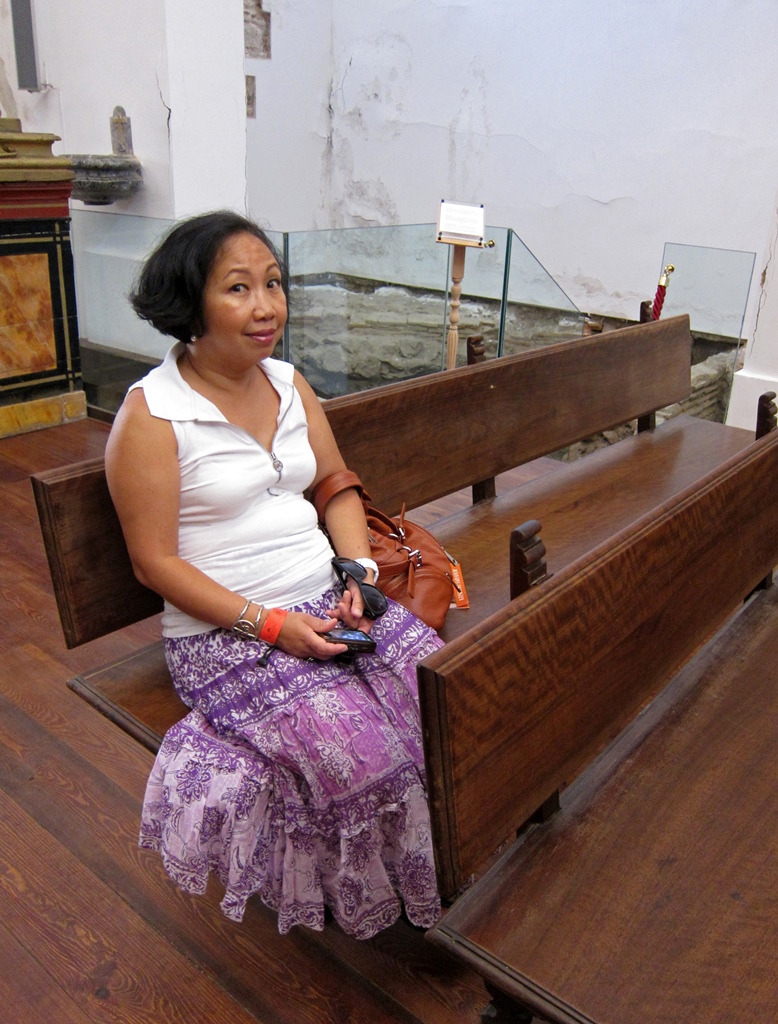
Nella
The church's history, however, is of considerable interest. When the Christians took over the
city's principal mosque in 1087 (turning it into their cathedral), the town's Muslims needed a new
main mosque. They ended up conferring this status on an existing mosque in the space now occupied by
the El Salvador Church. This lasted until 1159, when the Christians took over the mosque and turned
it into the Church of El Salvador. A 15th Century fire forced a rebuild, and in 1479 Queen Isabella
chose to have her daughter Joanna baptized here. Joanna would grow up to become Joanna I of Castile,
who would not actually rule as monarch due to reputed looniness (she would be called "Joanna the Mad",
and her father, Ferdinand of Aragon, would serve as regent following the death of Isabella). The
fortunes of the church have ebbed and flowed over the centuries (e.g. other fires, damage and theft
inflicted by Napoleon's soldiers), and diminished attendance has led to its present status, that of a
filial church in the Santo Tomé parish.
But another thing the church has become is a significant archaeological site. Excavations are going
on in the adjoining churchyard and under the church itself, mainly yielding artifacts and structural
elements from the mosque that once existed here. A short stairway from the church interior leads to
excavation areas that can be explored by visitors.
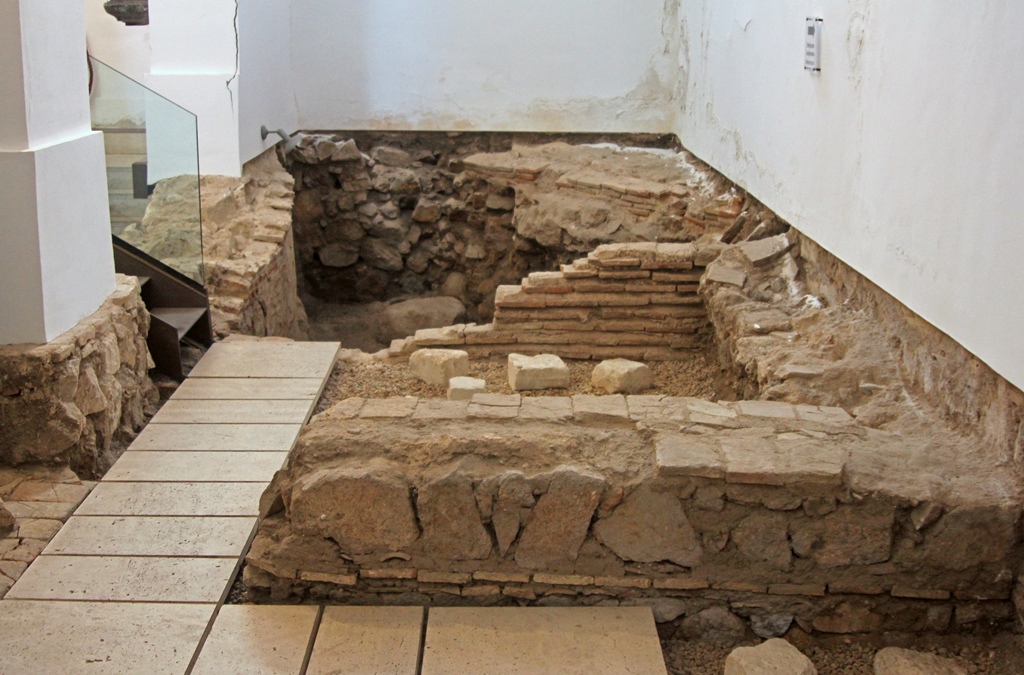
Excavation with Walkway
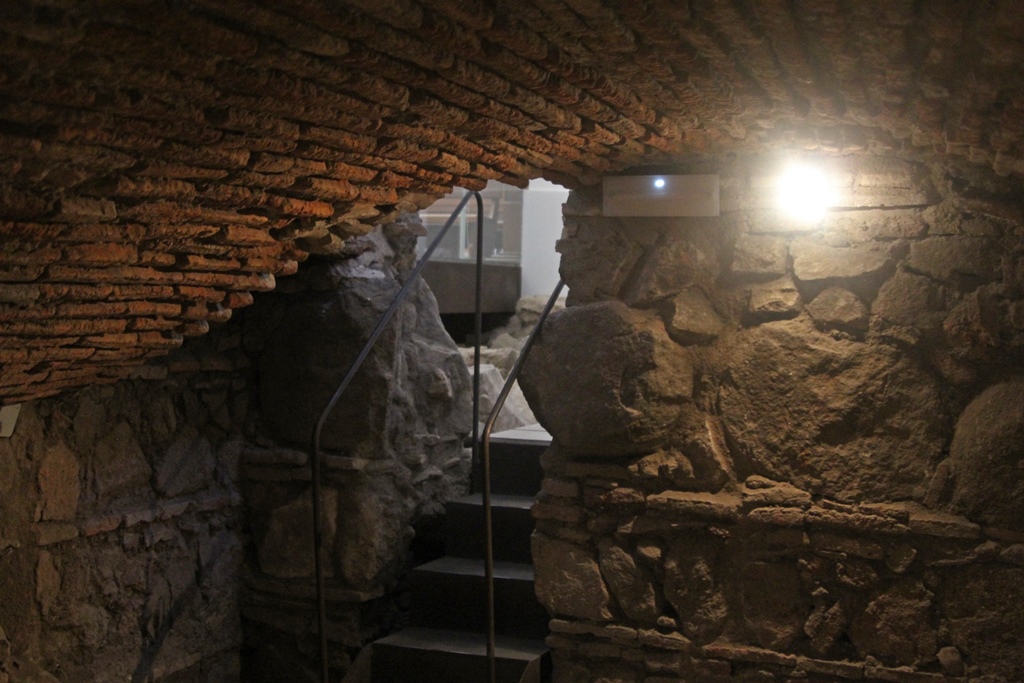
Underground Excavation
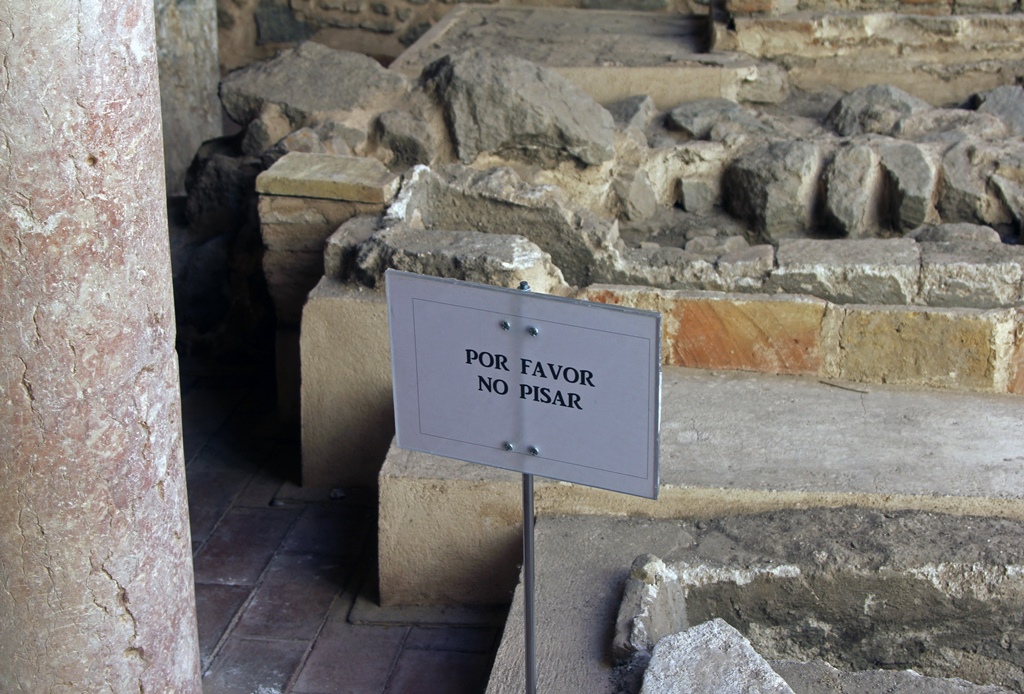
"Don't Touch" - Not What You're Thinking
It is thought that some sort of visigothic structure (and before that, even Roman construction)
existed on the site before the original mosque was built. Artifacts have been found in the
excavations, and even in the structure of the church itself, but this doesn't actually prove the
existence of older on-site structures, as it was common practice to incorporate old bits and
pieces into construction going on in separate locations. In the El Salvador Church, for example,
artifacts are used in the columns of the arcade on the right side of the church, but it's not
clear exactly where these artifacts came from. To be precise, the capitals on the tops of the
columns are of Roman origin, and one column in particular is a visigothic pilaster elaborately
carved with depictions of miracles performed by Christ.
Visigothic Pilaster
The church has a modest bell tower, which was built using the mosque's minaret as a starting
point. It's possible to walk up into the tower to see the bells and to enjoy the view. This
would have to qualify as light exercise, as the tower is only about 40 feet tall. The view is
as modest as the tower.
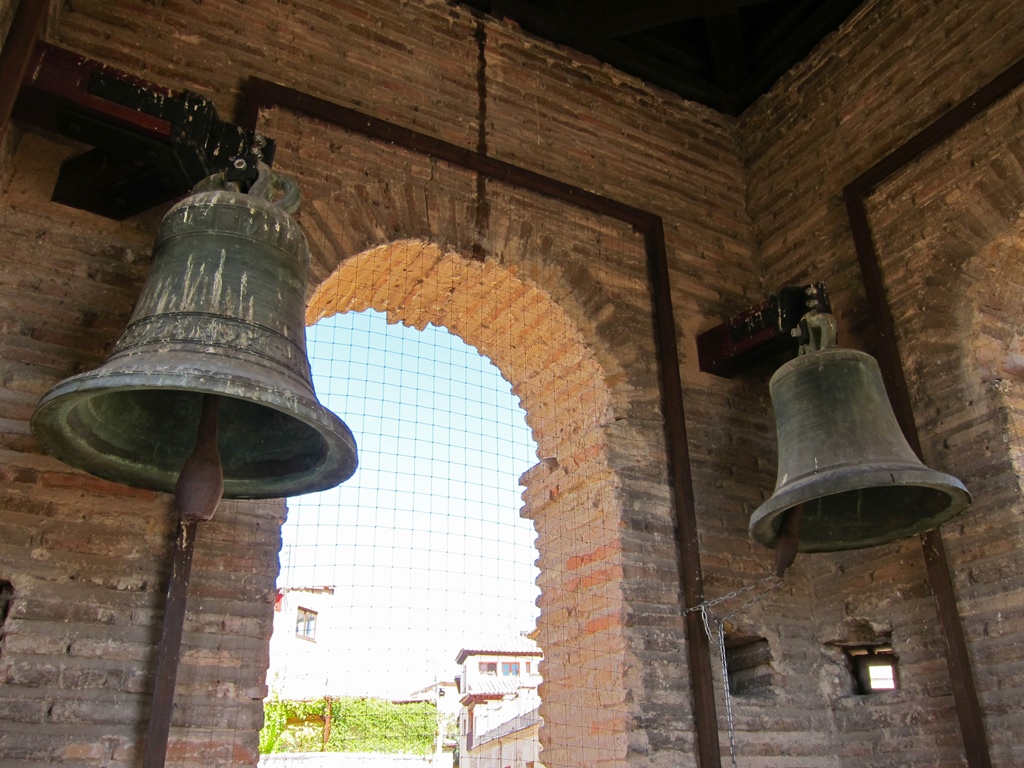
In the Bell Tower

Buildings from Bell Tower
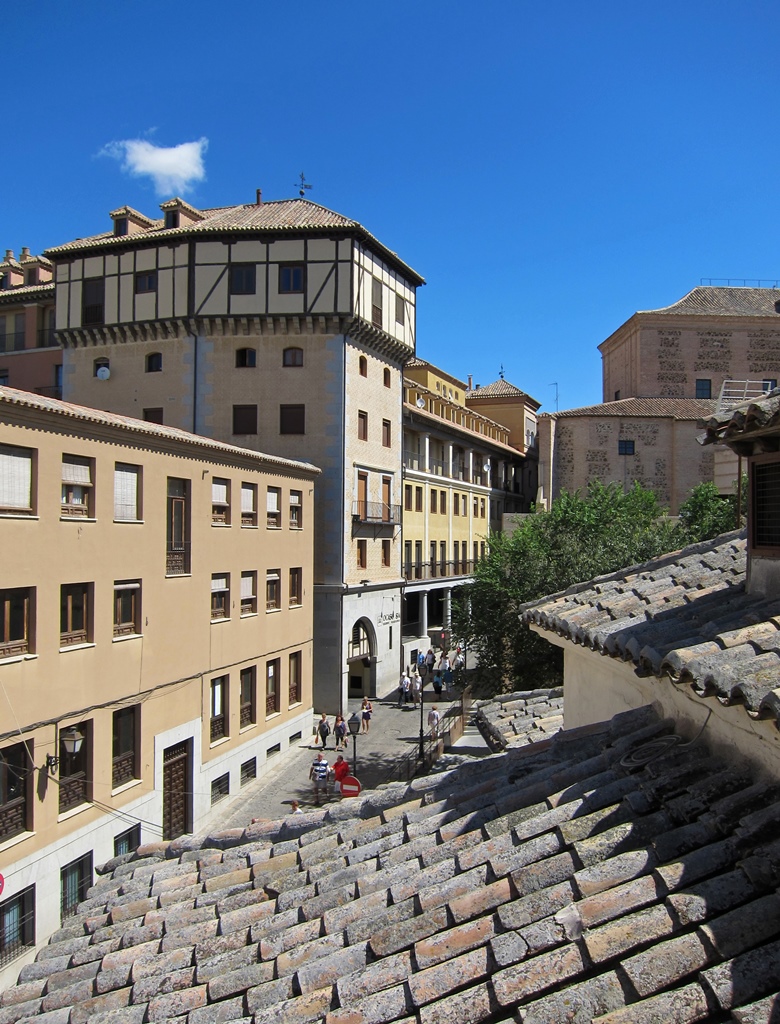
Calle Trinidad from Bell Tower
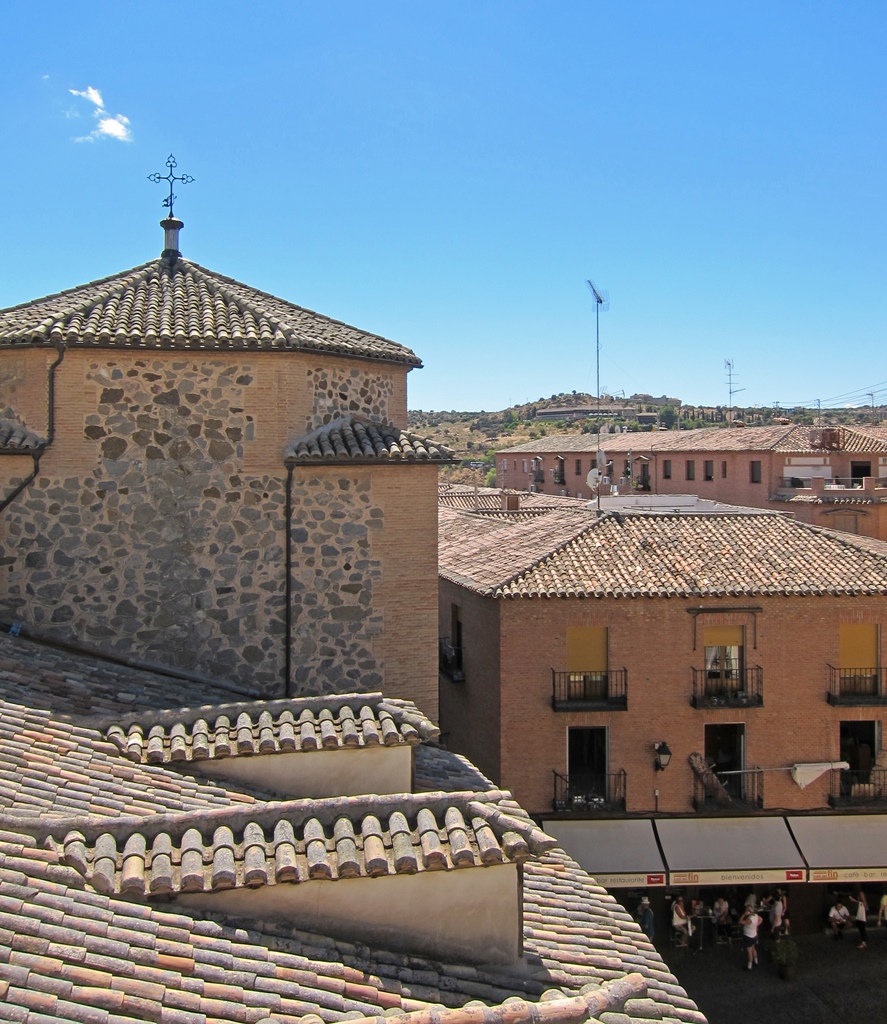
Roof and Calle Santa Ursula from Bell Tower
At this point we weren't quite done exercising our wristbands. We had one more church to visit,
the nearby Iglesia de los Jesuitas. This church had enough in it to justify a page of its own.




